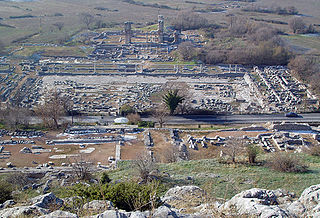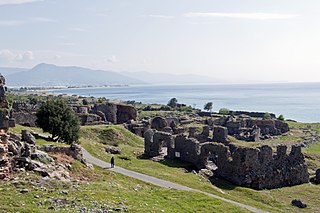
Amphipolis was an important ancient Greek polis (city), and later a Roman city, whose large remains can still be seen. It gave its name to the modern municipality of Amphipoli, in the Serres regional unit of northern Greece.

Philippi was a major Greek city northwest of the nearby island, Thasos. Its original name was Crenides after its establishment by Thasian colonists in 360/359 BC. The city was renamed by Philip II of Macedon in 356 BC and abandoned in the 14th century after the Ottoman conquest. The present village of Filippoi is located near the ruins of the ancient city and is part of the region of East Macedonia and Thrace in Kavala, Greece. The archaeological site was classified as a UNESCO World Heritage Site in 2016 because of its exceptional Roman architecture, its urban layout as a smaller reflection of Rome itself, and its importance in early Christianity.

Butrint was an ancient Greek polis and later Roman city and the seat of an early Christian bishopric in Epirus.

Nesebar is an ancient city and one of the major seaside resorts on the Bulgarian Black Sea Coast, located in Burgas Province. It is the administrative centre of the homonymous Nesebar Municipality. Often referred to as the "Pearl of the Black Sea", Nesebar is a rich city-museum defined by more than three millennia of ever-changing history. The small city exists in two parts separated by a narrow human-made isthmus with the ancient part of the settlement on the peninsula, and the more modern section on the mainland side. The older part bears evidence of occupation by a variety of different civilisations over the course of its existence.

Heraclea Lyncestis, also transliterated Herakleia Lynkestis, was an ancient Greek city in Macedon, ruled later by the Romans. Its ruins are situated 2 km (1.2 mi) south of the present-day town of Bitola, North Macedonia. In the early Christian period, Heraclea was an important Episcopal seat and a waypoint on the Via Egnatia that once linked Byzantium with Rome through the Adriatic seaport of Dyrrachium. Some of its bishops are mentioned in synods in Serdica and other nearby towns. The city was gradually abandoned in the 6th century AD following an earthquake and Slavic invasions.

Stobi or Stoboi, was an ancient town of Paeonia, later conquered by Macedon, and finally turned into the capital of the Roman province of Macedonia Salutaris. It is located near Gradsko, North Macedonia, on the main road that leads from the Danube to the Aegean Sea and is considered by many to be the most famous archaeological site in North Macedonia. Stobi was built where the Erigon joins the Axios (Vardar), making it strategically important as a center for both trade and warfare.

Phanagoria was the largest ancient Greek city on the Taman peninsula, spread over two plateaus along the eastern shore of the Cimmerian Bosporus.

Elaiussa Sebaste or Elaeousa Sebaste was an ancient Roman town located 55 km (34 mi) from Mersin in the direction of Silifke in Cilicia on the southern coast of Anatolia.

Apollonia in Cyrenaica was founded by Greek colonists and became a significant commercial centre in the southern Mediterranean. It served as the harbour of Cyrene, 20 km (12 mi) to the southwest.

Phoenice or Phoenike was an ancient Greek city in Epirus and capital of the Chaonians. It is located high on an almost impregnable hill commanding the fertile valley below and near the modern town of the same name, Finiq, in southern Albania. It was the wealthiest city in Epirus and had the strongest walls until the Roman conquest. It was the location of the Treaty of Phoenice which ended the First Macedonian War. The city is part of an archaeological park.

Ulpiana was an ancient Roman city located in what is today Kosovo. It was also named Justiniana Secunda (Latin: Iustiniana Secunda, Albanian: Justinianë Sekundë. Ulpiana is located in the municipality of Gračanica, 12 km southeast of Pristina. The Minicipium Ulpiana or Iustiniana Secunda was proclaimed an archaeological park under the permanent protection of Kosovo by the Kosova Council for Cultural Heritage in 2016. The archaeological park has an area of 161.10 hectares and a surrounding protection zone of 96.23 hectares. Ulpiana was among the largest settlements in the Balkans in late antiquity.

Anemurium, also called Animurium, is an ancient city whose ruins, now called Eski Anamur or Anemuryum, are close to the modern Turkish city of Anamur. It was in the Roman province of Cilicia, later Isauria, and was situated near a high promontory that marks the southernmost point of Asia Minor, only 64 km from Cyprus. In the Middle Ages, it was called Stallimur.

Histria or Istros was founded as a Greek colony or polis on the western coast of the Black Sea near the mouth of the Danube whose banks are today about 70 km away. In antiquity, it also bore the names Istropolis, Istriopolis, and Histriopolis or simply Istros/Histros (Ἴστρος). It is near the modern town of Istria.

Byllis or Bullis or Boullis (Βουλλίς) was an ancient city and the chief settlement of the Illyrian tribe of the Bylliones, traditionally located in southern Illyria. In Hellenistic times the city was either part of Illyria or Epirus. In Roman times it was included within Epirus Nova, in the province of Macedonia. The remains of Byllis are situated north-east of Vlorë, 25 kilometers from the sea in Hekal, Fier County, Albania. Byllis was designated as an archaeological park on 7 April 2003 by the government of Albania.

Ratiaria was a city founded by the Moesians, a Daco-Thracian tribe, in the 4th century BC, along the river Danube. In Roman times it was named Colonia Ulpia Traiana Ratiaria.

Corinth was a city-state (polis) on the Isthmus of Corinth, the narrow stretch of land that joins the Peloponnese peninsula to the mainland of Greece, roughly halfway between Athens and Sparta. The modern city of Corinth is located approximately 5 kilometres (3.1 mi) northeast of the ancient ruins. Since 1896, systematic archaeological investigations of the Corinth Excavations by the American School of Classical Studies at Athens have revealed large parts of the ancient city, and recent excavations conducted by the Greek Ministry of Culture have brought to light important new facets of antiquity.

Umm Qais, also known as Qays, is a town in northern Jordan principally known for its proximity to the ruins of the ancient Gadara. It is the largest city in the Bani Kinanah Department and Irbid Governorate in the extreme northwest of the country, near Jordan's borders with Israel and Syria. Today, the site is divided into three main areas: the archaeological site (Gadara), the traditional village, and the modern town of Umm Qais.

Etenna was a city in the late Roman province of Pamphylia Prima. Centuries earlier, it was reckoned as belonging to Pisidia, as by Polybius, who wrote that in 218 BC the people of Etenna "who live in the highlands of Pisidia above Side" provided 8000 hoplites to assist the Seleucid usurper Achaeus.

The Catholic Diocese of Sufetula was an ancient bishopric in the city of Sufetula, on the site of modern Tunisian Sbeitla, in the Roman province of Byzacena.

Pydna was an ancient Greek city in what is now the regional unit of Pieria, Central Macedonia, Greece. It is an important place in the history of Pieria and a major archaeological site located directly at the Aegean Sea, 16 km northeast of Katerini, 28 km north-east of Dion and 2.5 km from the village of Makrygialos. Nearby are two Macedonian tombs, discovered by the French archaeologist Heuzey during his Greek travels in the mid-19th century. Furthermore, the fortress-like bishop's seat Louloudies is located a few kilometers south of Pydna.





















